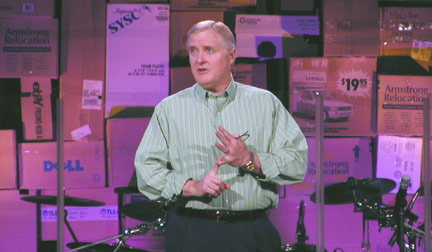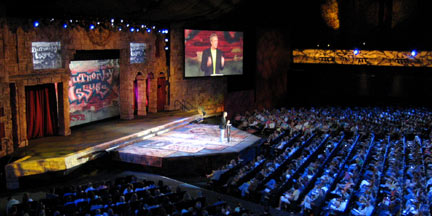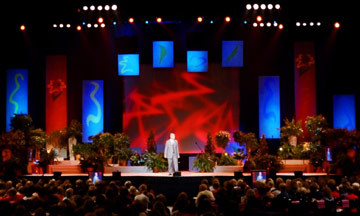Production Matters II - Immersion and Unity
by C. Andrew Dunning
Part 2 of 3 - Originally published in the October 2006 issue of Church Production Magazine.
Click HERE for Part 1 (Mindset Transformation) or HERE for Part 3 (Risk Taking and Communication).
In the last issue of Church Production Magazine I talked about personal transformation and the quest for excellence in the production arts in the church. I talked about overcoming the hindrance of the "we can't do that" attitude stemming from two basic mind-sets: "We don't have the budget to do any interesting production."; and "Our church is pretty reserved. That technology would never fit in here."
I talked of embracing concepts to enhance your message and your church's
personality, and not focusing solely on equipment. I encouraged you to look
at the ideas that you see in/behind other applications - and not limiting
yourself just to seeing particular equipment used in specific ways.
In this article, I'll be discussing two more facets of a positive mindset
that will help to enhance your message and help to create lasting impressions
with your congregations. The first is the goal of making church services
immersive experiences. Closely connected is the concept of "unity of
design."
Enhancing the Experience
When we say "church," the first things that pop into many people's
minds have to do with the larger-group, corporate service. These gatherings
exist to encourage fellowship and worship, to provide teaching, and to evangelize.
The reality, though, is that for many people "church" is passive.
They attend services, leaving unaffected and unchanged - and there is no
other place where they are making spiritual connections.
We in the "production arts" have the immense mission of helping
to create atmospheres where people do make a profound personal connection
- both with each other and with Christ. Along with the worship leaders,
we have the responsibility of reinforcing the reality that "church"
is to be personal - an experience - not an observation of a performance.
Participants need to be intentionally drawn in, engaged, submerged, involved.
They need to be taken on a journey.
Though having little to do with production technology, a perfect example
of being immersed in a worshipful atmosphere is the traditional singing
of Silent Night by candlelight on Christmas Eve. In large and small churches
alike there is a real sense of participants sharing in an experience - the
experience of being in the middle of a sea of candlelight singing with others.
There is no reason that this sharing has to be limited to Christmas Eve.
In a similar way, production elements can be used every single week to enhance
the particular personality of your church and its services.
Unity of Design
Dovetailing with this is the idea of unity of design. Another word for this
concept is "continuity." Simply put, this is the goal of having
the different service elements (the sermon, the music, any drama, the graphics
- both on-screen and in the printed material, the scenery, the audio, and
the lighting) reinforce or complement each other - with each pointing to
the purpose and tone of the service, to each other, and to the personality
and message of the church.
Examples
You may be thinking to yourself that these might be good-sounding theories,
but wondering what they look like in "real life." Here are some
things to consider.
Try to discern the theme of a given sermon series or event. Ask yourself
if there are visuals that can point to that theme - things that can give
the series a visual identity. For example, one church's sermon series had
to do with being ready for the great moves for which God may be preparing
us. A background of household moving boxes was created, filling the width
of the stage. The bulletins had moving-themed graphics. On the final Sunday
of the series every one in the congregation was given a tiny box to take
home. The box was a tangible symbol of the challenges given by the pastor.
At another church, a sermon had to do with money. The service opened with
the O'Jays song "For the Love of Money". Following some corporate
worship was a drama having to do with greed and money. The pastor then came
out and taught from within the scene (one familiar to everyone in the congregation
- a kitchen) used by the drama, often referring to the characters and even
interacting with the props from time-to-time.
Even if there are not theme-specific elements, visual unity and immersion
can still be achieved by not stopping on-stage with scenery or graphic elements.
Scenery can extend out beyond perceived boundaries, like proscenium walls.
This will help the audience to feel like they are part of the world on-stage.
Put visual hints throughout the room of an on-stage locale or pattern. Some
churches carry the themes out into the lobby and even the parking lot. One
church created a scenic look that mimicked ancient Southwestern ruins. The
scenery extended out well beyond the proscenium opening. Gobos in ellipsoidals
were used to project a "stonework" pattern onto the room's balcony
face. That pattern not only helped to "put" the congregation "inside"
the ruins, but also helped to add much-needed texture to certain camera
shots. Adding subtle texture and/or color with lighting can make a huge
difference in the feel of a room, giving it life.
If yours is a church where lighting is programmed for the music and/or dramatic
elements, don't spend all of your time on those things and miss a great
opportunity with the sermon. Too often, a service is beautifully lit, reinforcing
the music and helping to evoke emotion, and then, when the sermon begins,
things are taken to a sterile, unappealing state. Used carefully, color
can be a powerful tool to reinforce a given sermon's message and tone. For
example, different background graphics and colors can be used to enhance
the different parts of a service or event. "Happier" colors, like
magentas and ambers are often the right choices for more lively segments.
Reds and blues can be used for more intense or somber talks.
As you're lighting the stage, include the audience. Where appropriate, use
similar texture and/or color to what you're using on-stage. As part of an
Easter service one church presented the Nicole Nordeman song "One Drop".
On the line "One drop of crimson covers me" following a drop of
blood shown in video screens, the singer, and then the congregation, were
bathed in deep red light - as if the drop of crimson were covering all in
the room.
Consider intentionally not lighting something happening on-stage while lighting
the audience, thus shifting the focus. A great example of this is that moment
in worship when the congregation is fully engaged with singing a particular
song and the worship leader steps back from his or her microphone, allowing
the worship to lead itself.
Engaging your congregations in different ways does not necessarily mean
special scenery or lighting. For example, simply try moving action off of
the stage and into aisles or the audience. This can apply to drama, to music,
and to the teaching parts of services. Force people to do more than to stare
straight ahead.
If video reinforcement is part of your services, include lyrics - even with
the "special" songs. This will help people to follow along with
what a soloist is singing.
Some words of caution as you think about these things. Creative production,
no matter how immersive or unified, is no replacement for sound and compelling
teaching. If you miss that fact, the "show" will become "the
thing" and not the real focus of why we meet corporately in the first
place. I was recently in a service planning meeting. In the midst of working
through the service order, graphics content, and staging we ended up spending
quite a bit of time discussing the sermon with the pastor - asking questions
and making comments. Though some of the team members got a bit frustrated
because we weren't being "creative" in their eyes, others could
not have been happier. Before going different directions with the production
elements, they felt it important to understand where their pastor was being
led. They understood that their roles weren't to replace his teaching, but
to support it. To create with a different mindset would have been detrimental
to the purpose of the service.
Also, remember that it is not always appropriate to use all of these ideas
for every service. The thing is for these techniques to encourage the purpose
of "church," not to draw attention to themselves. There is a fine
line between enhancing and distracting. This line will be in different places
for different churches.
Conclusion
Continue to pursue excellence in your individual arts, but don't miss the importance of helping to foster personal experiences with unified vision. Pursuing that goal will help to make your services' messages stronger. They'll help to communicate a clearer sense of identity for your services and events. You'll help to create longer-lasting impressions.


